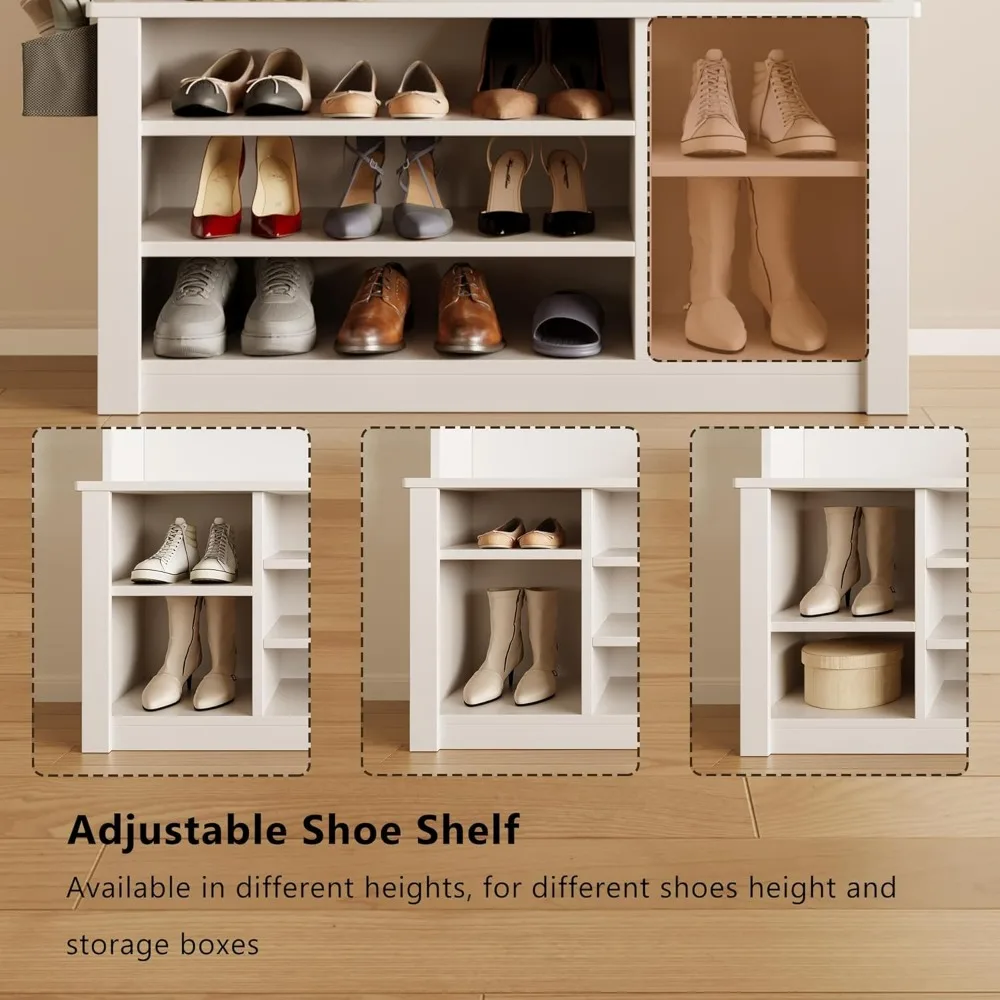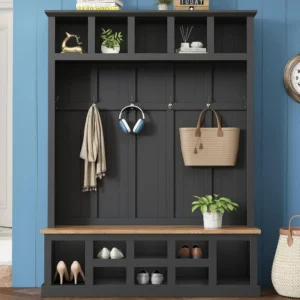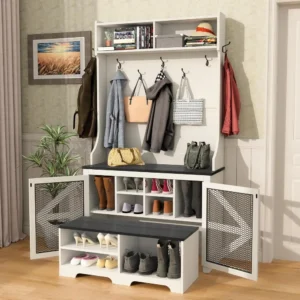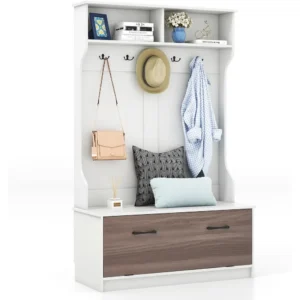Introduction: Transform Your Entryway with Functional Storage Solutions
Walking into a home with a cluttered entryway can instantly create stress and confusion. Coats draped over chairs, shoes scattered across the floor, and nowhere to sit while removing boots – these common entryway challenges affect both daily function and first impressions. Bench and coat hook combinations offer an elegant solution to this everyday chaos by merging comfortable seating with practical hanging storage in one streamlined piece of furniture.
The entryway serves as both the welcome point and transition zone of your home, yet studies show it’s often the area that accumulates the most clutter in the average household. By implementing thoughtful storage solutions in this high-traffic area, you can create an organized and inviting space that sets the tone for your entire home. The right bench and coat hook combination transforms these often overlooked areas into functional, stylish spaces that enhance your daily routine.
These versatile pieces do more than just store coats and provide seating – they can dramatically alter how your home functions on a daily basis. From streamlining morning routines to creating polished first impressions for guests, the benefits extend far beyond simple organization. Implementing space-saving benches for entryways can completely revitalize your home’s entrance while providing practical daily utility.
Why Invest in a Bench and Coat Hook Combination?
Space Optimization: Most entryways and mudrooms have limited square footage. Bench and coat hook combinations utilize vertical space efficiently by stacking storage functions. Rather than dedicating separate floor space for seating and coat storage, these all-in-one solutions typically occupy just 12-24 inches (30-61 cm) of depth while providing multiple storage functions. This smart use of space is particularly valuable in apartments and smaller homes where every square foot matters.
Clutter Reduction & Organization: By providing designated places for everyday items like coats, bags, umbrellas, and shoes, these combinations naturally reduce clutter. When everything has a dedicated spot, items are less likely to be tossed onto nearby furniture or accumulate in piles. The structured storage approach transforms chaotic entryways into organized transition zones where family members can quickly find what they need when heading out or put items away when arriving home.
Functional Seating: Having a comfortable place to sit while putting on or removing shoes is a convenience that quickly becomes indispensable. This seemingly simple feature eliminates the awkward balancing act of standing on one foot or using nearby furniture not designed for this purpose. For families with young children or elderly members, this seating becomes even more essential for maintaining stability and independence during daily transitions.
Enhanced Home Aesthetics: Beyond pure function, these pieces serve as statement furniture that can elevate your entryway’s design. A well-chosen bench and hook combination becomes a focal point that sets the tone for your home’s interior style. This dual-purpose furniture eliminates the mismatched look of separate utility pieces while creating a cohesive, intentional entrance area that welcomes both residents and guests.
Durability & Versatility: Quality hall trees and coat rack benches are built to withstand the demands of high-traffic areas. With sturdy construction designed for daily use by multiple family members, these pieces represent a lasting investment in home organization. The best options feature strong hooks that can hold heavy winter coats and bags while providing stable seating for adults.
Types of Bench and Coat Hook Combinations for Every Home
Hall Trees/Entryway Organizers
Hall trees represent the most comprehensive all-in-one solution, featuring a bench with integrated coat hooks above and often additional storage in the form of cubbies, drawers, or shelving. These freestanding units create a complete entryway station and serve as substantial furniture pieces.
Pros:
– Comprehensive all-in-one solution requiring no installation
– Substantial storage capacity for multiple household members
– Makes a strong design statement as a furniture piece
– Available in countless styles from rustic to ultra-modern
Cons:
– Requires more floor space (typically 36-48 inches/91-122 cm wide)
– Less flexibility for custom arrangements
– Higher price point than separate components
– More challenging to move or reconfigure later
Traditional entryway hall trees work best in spaces with at least 3 feet (91 cm) of wall space and sufficient clearance for doors and traffic flow. They typically range from $150-800 depending on materials, construction quality, and storage features.
Wall-Mounted Bench & Hook Sets
These space-saving solutions consist of a wall-mounted bench with separate coat hooks installed above. The modular approach allows for customization based on available space and specific needs.
Pros:
– Maximizes floor space with floating design
– Highly customizable in width and configuration
– Can fit into narrow or awkward spaces
– Often more affordable than full hall trees
– Can be installed at custom heights
Cons:
– Requires wall mounting and potential reinforcement
– May not provide as much storage as freestanding units
– Installation errors can lead to stability issues
– Limited weight capacity compared to floor-supported options
Wall-mounted combinations excel in smaller spaces where floor clearance matters. They’re ideal for narrow hallways and compact apartments where organizing a small entryway with a bench requires creative solutions. These typically range from $100-350 depending on materials and features.
Freestanding Bench with Separate Coat Rack
This flexible arrangement pairs a standalone entryway bench with a separate coordinating coat rack, allowing for adaptable spacing and configuration based on your specific layout needs.
Pros:
– Maximum flexibility in arrangement
– Can be separated or repositioned as needs change
– Works well in unusual room configurations
– Allows for mixing different styles or materials
– Can be purchased gradually to spread out cost
Cons:
– Takes up more total floor space than integrated units
– May lack the cohesive look of single-piece solutions
– Could require more assembly steps
– Often less storage efficiency than integrated designs
This flexible option works well in entryways with unusual dimensions or where furniture may need to be rearranged seasonally. Price ranges typically span $120-400 for quality component sets.
Built-In Mudroom Bench & Storage Systems
Custom or semi-custom built-in solutions integrate permanently into your entryway or mudroom, maximizing every inch of available space with tailored storage.
Pros:
– Perfectly fits your exact space dimensions
– Maximizes storage efficiency with custom configurations
– Creates a high-end, integrated look
– Can incorporate specialized storage for unique needs
– Adds potential home value as a permanent improvement
Cons:
– Highest cost option in most cases
– Permanent installation limits future flexibility
– Requires professional design and installation
– Longer timeline from concept to completion
Built-in solutions typically start around $500 for basic configurations and can exceed $2,000 for custom cabinetry quality with advanced storage features. These are ideal for dedicated mudrooms or larger entryways where permanent solutions make sense.
Key Features to Look for in Quality Bench and Coat Hook Combinations
Storage Capacity & Configuration
The most functional entryway coat rack benches offer thoughtfully designed storage suited to your household’s specific needs.
Hook Options and Weight Capacity:
– Look for double-prong hooks that prevent items from slipping off
– Metal hooks typically support more weight than wooden pegs
– Quality units feature hooks rated for 10-15 pounds (4.5-6.8 kg) per hook
– Consider hook spacing of at least 6 inches (15 cm) to prevent crowding
– Adjustable or repositionable hook systems offer maximum flexibility
Bench Storage Variations:
– Lift-top benches conceal items completely but limit quick access
– Open cubbies provide easy access but items remain visible
– Drawers offer the best dust protection but with reduced capacity
– Baskets and bins create removable, washable organization systems
– Under-bench clearance allows for shoe storage without additional features
Additional Shelving Possibilities:
– Upper shelves work well for seasonal items or decorative displays
– Middle shelves provide perfect placement for frequently used items
– Wire shelving allows for air circulation around damp items
– Adjustable shelf systems adapt as your storage needs change
– Consider depth carefully – deeper shelves hold more but can create shadows
Specialized Shoe Storage Solutions:
– Slanted shoe shelves prevent footwear from falling forward
– Boot trays contain moisture and dirt from wet footwear
– Hidden compartments keep less attractive shoes out of sight
– Ventilated storage prevents odor buildup
– Consider capacity based on household size (typically 2-3 pairs per person)
Materials & Construction Quality
The materials used in your bench and coat hook combination directly impact its durability, appearance, and maintenance requirements.
Solid Wood Options:
– Oak and maple offer exceptional durability for high-traffic areas
– Pine provides a lighter weight option with rustic appeal
– Walnut brings rich coloring but at a premium price point
– Look for mortise and tenon joints for superior strength
– Solid wood typically offers the best long-term value despite higher initial cost
Engineered Wood Considerations:
– Medium-density fiberboard (MDF) provides smooth surfaces for painted finishes
– Particleboard with quality veneers can mimic solid wood at lower costs
– Look for formaldehyde-free construction in engineered options
– Sealed edges prevent moisture damage and delamination
– Quality hardware becomes even more crucial with engineered materials
Metal Components:
– Steel offers the highest strength-to-weight ratio
– Wrought iron provides classic styling with substantial weight
– Look for powder-coated finishes to prevent rust and chipping
– Welded joints outperform bolted connections for stability
– Consider weight capacity ratings before purchase
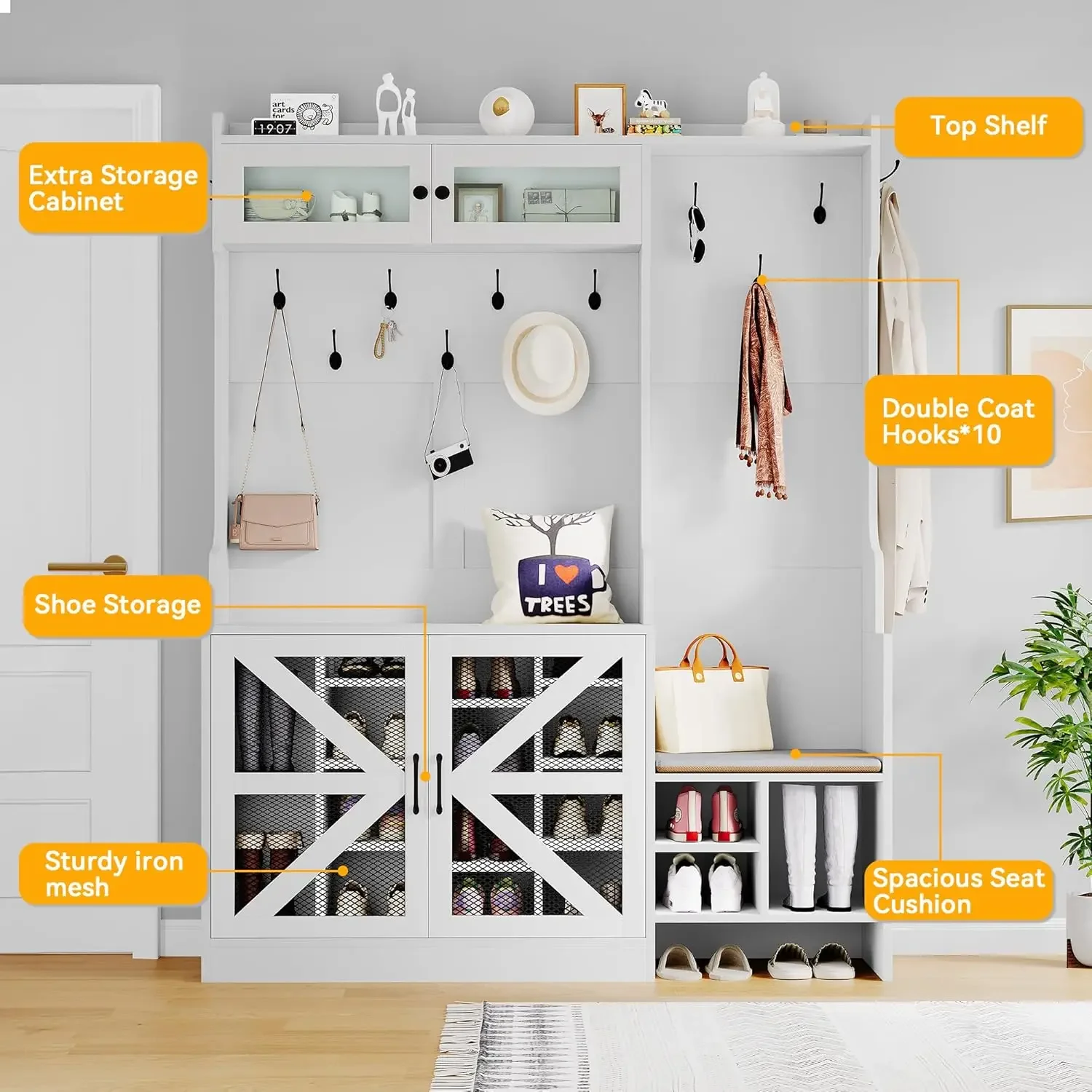
Upholstery Options:
– Performance fabrics resist stains and moisture
– Vinyl and leather-like materials offer easy cleaning
– Removable cushions simplify maintenance and replacement
– Foam density of 2.0 or higher prevents premature compression
– Weather-resistant options work well for unconditioned spaces
Hardware Quality:
– Soft-close hinges prevent slamming and extend furniture life
– Full-extension drawer glides provide complete access to contents
– Metal-to-metal connections outperform metal-to-wood for durability
– Heavy-duty mounting hardware is essential for wall-mounted options
– Look for adjustable levelers on feet to accommodate uneven floors
Dimensions & Space Requirements
Understanding spatial requirements ensures your chosen piece fits perfectly in your available space.
- Standard bench heights range from 17-20 inches (43-51 cm) for comfortable adult seating
- Minimum depth for comfortable seating is 14-16 inches (35-41 cm)
- Allow at least 24 inches (61 cm) of width per seated person
- Hooks should be positioned 60-72 inches (152-183 cm) from the floor for adult use
- Lower hooks at 30-48 inches (76-122 cm) improve accessibility for children
- Maintain at least 36 inches (91 cm) of clearance in front for comfortable use
- Door swing paths require complete clearance to prevent obstruction
Weight Capacity & Stability
Safety should never be compromised when selecting furniture that will support people and hold valuable items.
- Quality benches should support at least 250 pounds (113 kg) for standard models
- Commercial-grade options may support 400+ pounds (181+ kg)
- Individual hooks should hold 10-15 pounds (4.5-6.8 kg) each without loosening
- Wall-mounted units require proper anchoring to studs or solid masonry
- Anti-tip hardware is essential for tall freestanding units
- Stability cross-braces reduce wobble in freestanding models
- Look for wide feet or a substantial base on freestanding units
- Test stability before loading with valuable items
Matching Your Home’s Style: Design Options and Aesthetics
Farmhouse/Rustic
This welcoming style incorporates natural materials with a comfortable, lived-in appeal that’s perfect for family-friendly spaces.
Characteristics:
– Distressed or reclaimed wood with visible grain
– Black iron or bronze hardware with an aged appearance
– Bench cushions in neutral linen or cotton fabrics
– Open shelving rather than enclosed storage
– Typically in warm wood tones or white painted finishes
Color Palette: Cream, weathered gray, warm wood tones, sage green, and navy accents create the perfect farmhouse atmosphere. These neutral bases allow for seasonal accent changes through cushions and décor.
Modern/Minimalist
Clean lines and uncluttered surfaces define this contemporary approach to entryway organization.
Design Elements:
– Sleek silhouettes without ornate details
– Hidden storage compartments to minimize visual clutter
– Metal and glass components with minimal ornamentation
– High-contrast color combinations
– Flush hardware or touch-latch designs
Color Palette: Modern styles thrive in monochromatic schemes like white, black, and gray, often with a single bold accent color. Materials typically feature smooth, uniform finishes rather than textured or distressed surfaces.
Industrial
Combining raw materials with utilitarian design, industrial pieces bring urban loft aesthetics to residential spaces.
Key Components:
– Metal framework with exposed bolts or rivets
– Reclaimed wood with minimal finishing
– Pipe-style coat hooks or railroad spike designs
– Mesh or perforated metal storage components
– Minimal cushioning or leather/canvas seating surfaces
Color Palette: Industrial pieces typically showcase natural material colors – dark metals, warm woods, and neutral upholstery with occasional pops of rust red, factory yellow, or blueprint blue.
Traditional
Classic design elements create timeless entryway pieces that complement established home styles.
Classic Elements:
– Turned wood legs and decorative molding
– Rich wood stains in medium to dark finishes
– Brass or antiqued hardware
– Upholstered seating with classic patterns
– Symmetrical designs with balanced proportions
Color Palette: Traditional pieces favor rich wood tones like cherry, mahogany, and walnut, paired with classic navy, burgundy, forest green, or neutral upholstery.
Coastal/Bohemian
Light and airy designs that evoke vacation feelings and relaxed lifestyles.
Identifying Features:
– Whitewashed or light natural wood finishes
– Woven components like rattan or sea grass
– Blue and white color schemes with natural accents
– Open, airy designs with minimal visual weight
– Natural fiber cushions and textural elements
Color Palette: Coastal styles feature whites, creams, and light woods paired with ocean blues and seafoam greens, while bohemian designs add warm corals, turquoise, and yellow accents.
When selecting your bench and coat hook combination, consider how it will coordinate with both your entryway and adjoining rooms. The best pieces serve as a bridge between spaces, complementing your existing décor while fulfilling important organizational functions. Many homeowners find that space-saving entryway ideas can be implemented in any aesthetic style with the right selection.
How to Choose the Perfect Bench and Coat Hook Combination for Your Space
Finding the ideal entryway storage solution requires thoughtful consideration of your specific needs and space constraints. Follow this assessment framework to make a confident choice.
1. Evaluate Household Size and Daily Storage Needs
Begin by counting the number of people regularly using your entryway and cataloging what items they typically need to store:
– Count coats, bags, and accessories per person
– Consider seasonal variations (bulkier winter items)
– Account for guest storage needs
– Calculate typical shoe pairs in rotation
– List additional items like sports equipment, pet supplies, or children’s backpacks
For an average family of four, look for units with at least 6-8 hooks, seating for 2 adults, and storage for 8-12 pairs of shoes to accommodate daily use.
2. Measure Your Space and Analyze Traffic Patterns
Accurate measurements prevent disappointing returns and ensure comfortable movement:
– Measure width, height, and depth of your available wall space
– Note door swing paths and clearance requirements
– Identify electrical outlets and heating vents that cannot be blocked
– Mark high-traffic pathways that must remain clear
– Consider sightlines from adjoining rooms
Even compact spaces can accommodate functional storage when you select the right configuration. Wall-mounted hook and bench combinations offer excellent solutions for tight spaces where floor space is at a premium.
3. Assess Style Compatibility
Your entryway creates first impressions for your home:
– Identify your primary home style (modern, traditional, etc.)
– Consider existing colors and finishes to match or complement
– Determine if you want the piece to blend in or stand out
– Consider the transition between outdoor and indoor aesthetics
– Decide if this is an investment piece or temporary solution
4. Establish Budget Parameters
Quality bench and coat hook combinations span a wide price range:
– Entry-level ($100-250): Basic functionality, engineered materials
– Mid-range ($250-500): Better construction, partial solid wood
– Premium ($500-1,000+): Solid materials, advanced features, designer styles
– Custom built-ins ($1,000-3,000+): Tailored to your exact specifications
Balance initial cost against expected longevity. Higher-quality pieces typically offer better value over time despite higher initial investment.
5. Consider Future-Proofing
Anticipate how your needs might change:
– Children growing taller (hook height adjustability)
– Expanding family size (storage capacity)
– Potential moves to different homes (freestanding vs. built-in)
– Aging in place considerations (stable seating, easy access)
– Style longevity versus trend-focused designs
The most versatile pieces feature adjustable components, modular design, and timeless styling that adapts to changing needs.
Maximizing Your Bench and Coat Hook Combination: Storage Optimization Tips
Implement Seasonal Rotation Systems
Don’t overcrowd your entryway with out-of-season items. Create a seasonal rotation system where winter coats and accessories are stored elsewhere during summer months and vice versa. Use vacuum storage bags for off-season items and keep only current season outerwear in your entryway.Utilize Vertical Space Effectively
Many entryway units don’t maximize the full height potential. Add adhesive hooks inside cubbies for small items, install additional shelving above the main unit if ceiling height allows, or use stackable containers within storage compartments to create multiple layers of organization.Add Strategic Accessories
Enhance your storage capacity with carefully selected containers:
– Narrow baskets sized to fit cubbies contain small items like gloves and scarves
– Shoe trays with raised edges contain moisture and dirt
– Labeled bins help family members identify their designated spaces
– Drawer dividers prevent small item chaos
– Moisture-absorbing products protect from wet weather itemsCreate a “Landing Pad” System
Designate a small container or tray on your entryway bench for daily essentials like keys, phones, and wallets. This prevents these important items from being misplaced and creates a reliable “grab and go” station for busy mornings.Establish Family Organization Zones
For multi-person households, create visual or physical divisions in your storage system. Assign specific hooks, cubbies, or baskets to each family member, using consistent colors or labels to make the system intuitive. This approach works especially well with corner hall trees that offer multiple storage sections.
Design Ideas: Styling Your Entryway Storage to Enhance Your Home
Transform your functional storage piece into a design feature that elevates your entire entryway with these styling approaches.
Strategic Accessorizing
– Layer bench cushions with small, seasonal throw pillows for instant color updates
– Place a slim table runner across the bench to add pattern without compromising seating
– Install a large statement mirror above coat hooks to expand visual space and provide a last-minute appearance check
– Add a small tray for rotating seasonal décor items that won’t interfere with function
– Consider an entryway-appropriate plant like a snake plant or ZZ plant that thrives in variable light
Lighting Considerations
Proper lighting transforms how your entryway functions and appears:
– Wall sconces mounted alongside your unit provide warm, welcoming illumination
– A small table lamp on one end of the bench creates ambiance (if space allows)
– Motion-sensor stick-on lights inside cubbies improve visibility
– Consider plug-in picture lights above artwork for focused illumination
– String lights tastefully arranged during holidays add seasonal warmth
Creating Cohesion
Connect your entryway aesthetically to adjoining spaces:
– Repeat accent colors from neighboring rooms in bench cushions or accessories
– Choose art or photography that complements your home’s overall style
– Use consistent hardware finishes between your storage unit and nearby doors or fixtures
– Apply the same flooring treatment (rugs, runners) to create flow between spaces
– Maintain a similar level of formality in your entryway as in connected rooms
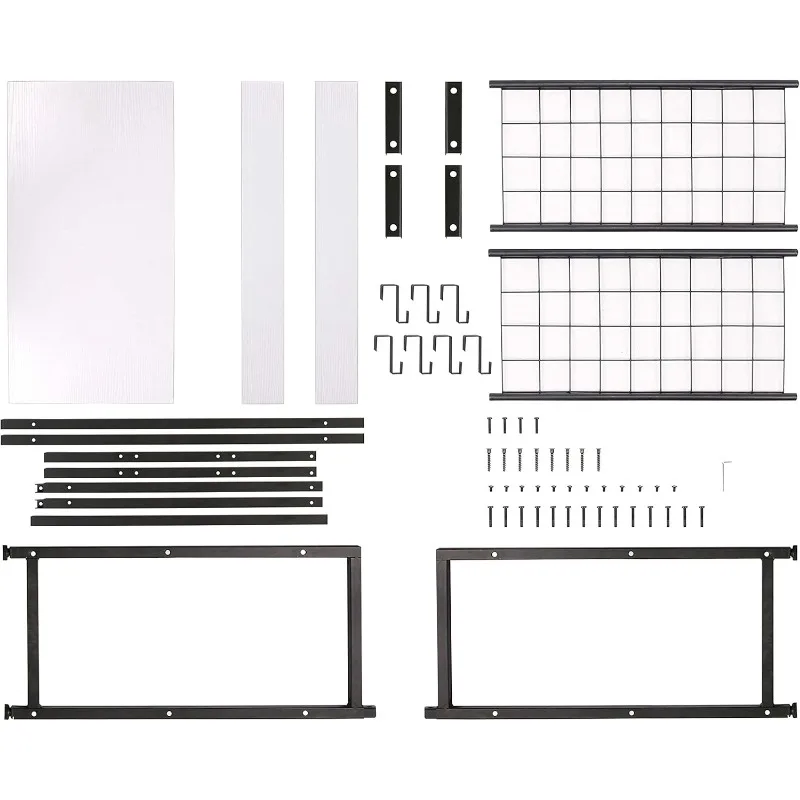
Coat Rack Shoe Bench, Corner Entryway Bench, Corner Hall Tree, Shoe Bench for Entryway
$313.58 Select options This product has multiple variants. The options may be chosen on the product pageBench with Hooks and Storage, Entryway Hall Tree, Mudroom Bench with Cubbies, Mudroom Bench with Shoe Storage
$818.38 Select options This product has multiple variants. The options may be chosen on the product pageEntryway Coat Rack Bench, Entryway Hall Tree, Farmhouse Mudroom Bench, Mudroom Bench with Shoe Storage
$805.09 Select options This product has multiple variants. The options may be chosen on the product pageBench with Hooks and Storage, Entryway Coat Rack Bench, Entryway Hall Tree, Mudroom Bench with Shoe Storage, Mudroom Coat Rack Bench
$793.73 Select options This product has multiple variants. The options may be chosen on the product pageCoat Rack Shoe Bench, Entryway Coat Rack Bench, Entryway Hall Tree, Wood Entryway Bench
$479.82 Select options This product has multiple variants. The options may be chosen on the product pageBench with Hooks and Storage, Entryway Coat Rack Bench, Entryway Hall Tree
$428.13 Select options This product has multiple variants. The options may be chosen on the product page
Installation and Maintenance: Ensuring Long-Term Satisfaction
Installation Best Practices
Proper installation ensures safety and functionality for years to come.
Wall-Mounted Units:
– Always locate and use wall studs for mounting heavy items
– Use appropriate anchors rated for the full weight when studs aren’t available
– Verify wall construction (drywall, plaster, concrete) and use appropriate hardware
– Use a level during installation to ensure straight mounting
– Consider professional installation for heavy or complex units
– Follow manufacturer’s specific instructions for your model
Freestanding Units:
– Assemble on a flat, clear surface to avoid scratching
– Tighten all hardware fully, checking connections every few months
– Use included wall-anchoring kits even for freestanding units to prevent tipping
– Adjust leveling feet to accommodate uneven floors
– Place protective pads under legs to prevent floor damage
– Allow adequate clearance from heating vents and radiators
Care and Maintenance
Different materials require specific care approaches to maintain appearance and function:
Wood Surfaces:
– Dust regularly with a soft, slightly damp cloth
– Clean spills immediately to prevent staining
– Apply appropriate wood polish or conditioner 2-3 times yearly
– Avoid harsh chemical cleaners that can damage finishes
– Touch up minor scratches with matching repair markers
– Keep out of direct sunlight to prevent fading and cracking
Metal Components:
– Wipe with a dry cloth to remove dust
– Use mild soap and water for stubborn dirt, drying immediately
– Apply paste wax to painted metal surfaces yearly for protection
– Check for and treat any rust spots immediately
– Tighten any loose screws or bolts during regular cleaning
– Use touch-up paint recommended by the manufacturer for chips
Upholstered Elements:
– Vacuum fabric surfaces regularly using upholstery attachments
– Treat stains immediately following fabric-specific guidelines
– Consider applying fabric protector to new pieces
– Test cleaning products on hidden areas before general application
– Remove cushion covers for washing if design allows
– Rotate cushions regularly to ensure even wear
Proper care significantly extends the life of your mudroom coat rack bench, making it a lasting investment in your home’s organization and appearance.
Smart Shopping: Where to Find Quality Bench and Coat Hook Combinations
Quality Assessment for Online Shopping
When you can’t physically examine a piece, look for these quality indicators:
– Detailed material descriptions specifying solid wood vs. engineered components
– Clear weight capacity specifications for both hooks and bench seating
– Close-up images of joints, hardware, and finishing details
– Customer reviews mentioning durability over time
– Assembly difficulty feedback from actual purchasers
– Clear dimensions with both overall and component measurements
– Warranty information and return policy details
Key Questions to Ask Retailers
Whether shopping online or in person, these questions help identify quality pieces:
– What materials are used in the frame construction?
– Are the wood components solid or engineered?
– What type of joinery is used at stress points?
– What is the weight capacity of the bench and individual hooks?
– Is the piece part of a continuing line (for future matching additions)?
– What is the expected assembly time and difficulty level?
– Are replacement parts available if needed later?
Value-Focused Options
Find the sweet spot between quality and affordability:
– Floor models often offer significant discounts on high-quality pieces
– Seasonal sales typically occur before major holidays and in January
– Warehouse and outlet stores for major furniture retailers
– Ready-to-assemble options from quality manufacturers
– Sets that include matching organizational accessories
For those prioritizing space efficiency in smaller homes, space-saving entry benches for small homes offer excellent functionality without overwhelming limited floor plans.
Common Questions About Bench and Coat Hook Combinations
What is the ideal height for coat hooks and benches?
Standard bench heights range from 17-20 inches (43-51 cm) from the floor for comfortable adult seating. Coat hooks are typically installed 60-72 inches (152-183 cm) from the floor for adult use. For households with children, consider installing some hooks at 40-48 inches (102-122 cm) to promote independence and accessibility.
How much space do I need for a functional entryway unit?
At minimum, allow for:
– 36 inches (91 cm) of width for a basic unit
– 16-20 inches (41-51 cm) of depth for the bench portion
– 36 inches (91 cm) of clearance in front for comfortable use
– 80 inches (203 cm) of height for standard coat hooks
How difficult is assembly for typical bench and coat hook combinations?
Assembly difficulty varies widely:
– Simple wall-mounted units: 20-40 minutes with basic tools
– Standard hall trees: 1-2 hours with intermediate skills
– Complex storage systems: 2-4 hours, sometimes requiring two people
– Pre-assembled options are available at higher price points
What features make entryway storage child and pet-friendly?
Look for:
– Rounded corners and edges to prevent injuries
– Stable, tip-resistant construction
– Lower hooks accessible to children
– Washable, stain-resistant fabrics
– Closed storage for items unsafe for children or pets
– Non-toxic finishes and materials
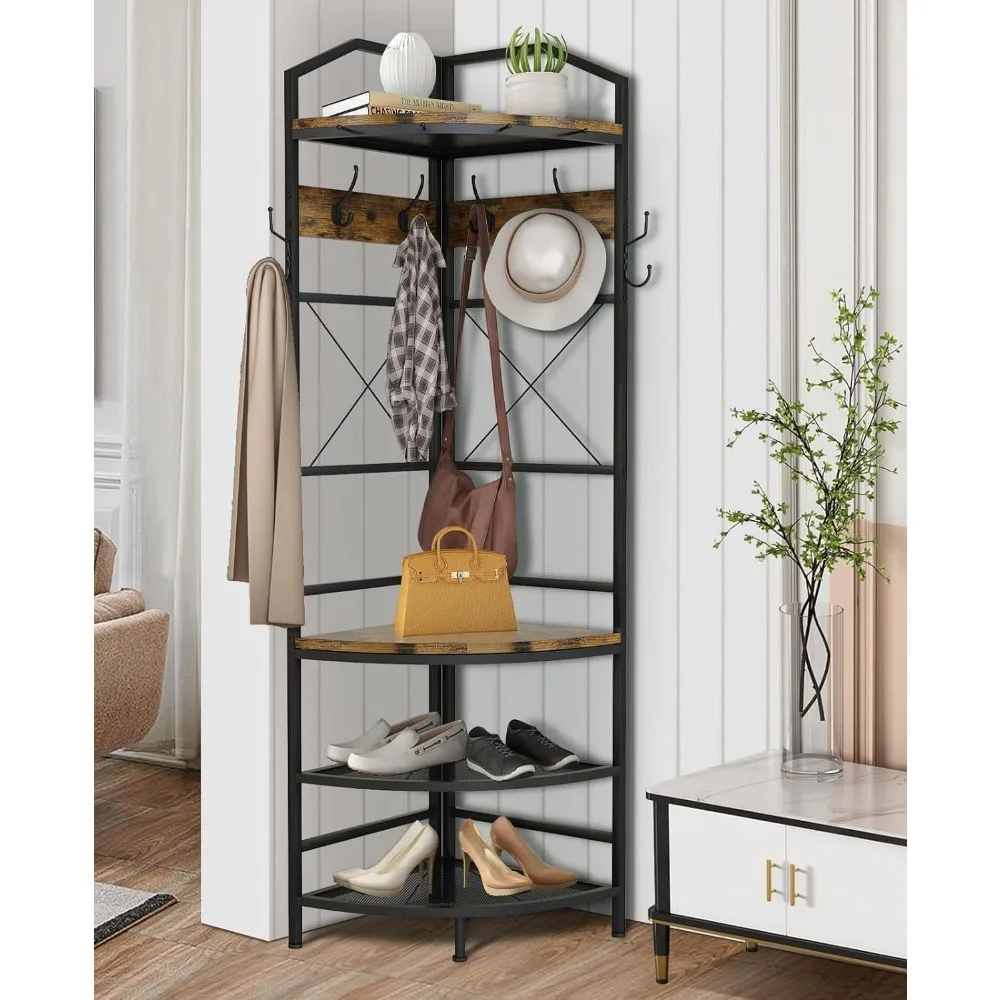
How can I determine if a bench will hold my family’s heavier winter coats?
Quality coat hooks should support 10-15 pounds (4.5-6.8 kg) each. For heavy winter gear, look for metal hooks with reinforced mounting rather than wooden pegs. Check manufacturer specifications for individual hook weight limits, as exceeding these can cause hooks to loosen or break over time.
How much storage capacity do average households need?
For a family of four, look for:
– 6-8 coat hooks minimum
– Storage for 8-12 pairs of shoes
– 2-4 cubbies or drawers for accessories
– Seating for at least 2 adults
– Consider seasonal rotation for additional capacity
What’s the lifespan difference between budget and premium options?
– Budget options ($100-250): Typically 2-5 years of heavy use
– Mid-range ($250-500): Generally 5-10 years with proper care
– Premium ($500+): Often 10-20+ years, sometimes becoming heirloom pieces
– The difference primarily relates to material quality, construction methods, and hardware durability
For those specifically seeking shoe storage combined with coat hanging options, coat rack shoe bench combinations offer specialized designs for footwear organization.
Creating Zones: Organizing Multiple Family Members’ Belongings
Effective family organization requires thoughtful systems that work for all household members.
Color-Coding Strategies
Assign consistent colors to family members across storage elements:
– Colored tags or paint dips on hooks for visual identification
– Coordinating basket colors in cubbies or drawers
– Matching hangers for each person’s items
– Colored dots on labels for younger children
– Consistent color themes that complement your overall décor
Height-Appropriate Organization
Adjust your storage system to accommodate various ages and heights:
– Install hooks at multiple heights (40-72 inches/102-183 cm)
– Place children’s storage cubbies at lower levels
– Position adult storage at eye level or higher
– Consider step stools for children that store neatly under the bench
– Implement a “graduation” system where storage locations evolve as children grow
Individualized Spaces Within Shared Storage
Create personalized zones without sacrificing style:
– Divide bench storage into equal sections with basket inserts
– Use subtle, attractive labels that enhance rather than detract from aesthetics
– Create custom silhouette tags for each family member
– Implement removable dividers in shared drawers
– Reserve premium positions (most accessible hooks) for most frequently used items
With proper organization, even benches with hooks and storage designed for shared use can provide personalized space for each family member while maintaining a cohesive look.
Small Space Solutions: Bench and Coat Hook Combinations for Compact Entryways
Limited square footage doesn’t mean sacrificing organization or style. These approaches maximize function in minimal space.
Space-Saving Designs
Look for units specifically engineered for smaller footprints:
– Corner-oriented designs that utilize often-wasted corner spaces
– Wall-mounted benches that float above the floor to create an airier feel
– Narrow-depth options (12-14 inches/30-36 cm) that project minimally into the room
– Vertical emphasis designs that utilize height rather than width
– Combination pieces that integrate mirrors to expand visual space
Multipurpose Features
In small spaces, each piece should serve multiple functions:
– Lift-top bench seating that reveals hidden storage
– Hooks that fold flat when not in use to minimize projection
– Convertible designs that expand for guests but collapse for daily use
– Built-in mirrors that eliminate the need for separate wall hangings
– Integrated umbrella stands or mail organization
Visual Space-Enhancing Techniques
Strategic design choices can make small entryways feel larger:
– Choose lighter finishes that recede visually
– Select pieces with legs rather than solid bases to create visual airiness
– Install mirrors above or adjacent to create depth
– Maintain consistent color schemes to prevent visual fragmentation
– Select streamlined designs without ornate details that can feel cluttered
For the smallest spaces, best small benches for entryways offer specialized proportions designed to fit tight areas while still providing essential organization.
The perfect bench and coat hook combination transforms your entryway from a chaotic drop zone into an organized, welcoming space that enhances daily routines. By carefully considering your specific needs, available space, and aesthetic preferences, you can select a storage solution that provides lasting functionality while beautifully complementing your home. Nested Goods offers a range of high-quality options designed to combine practical storage with elegant style, creating entryway solutions that truly work for modern living.

